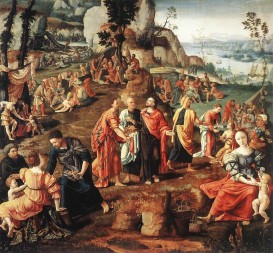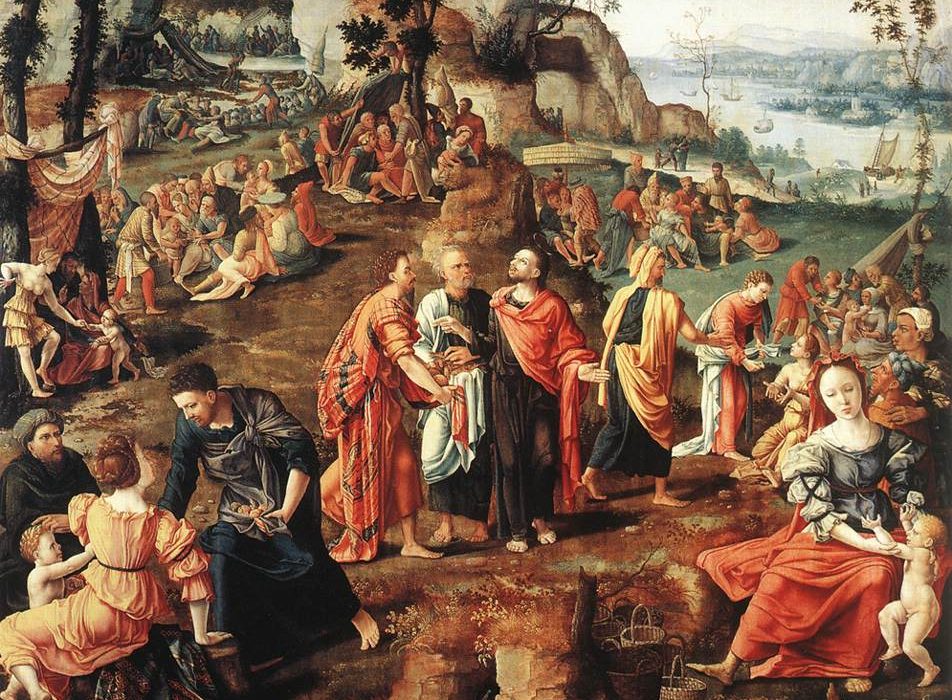July 21, 2015 // Uncategorized
“We Must Hunger for God!”

This oil artwork of Lambert Lombard’s “The Miracle of the Loaves and Fishes,” dates to the 16th century. It is displayed at Rockox House, Antwerp, Belgium.
The Catechism of the Catholic Church teaches about the unity of the divine plan in the Old and New Testaments and how the Church has illuminated this unity through “typology.” “Typology discerns in God’s works of the Old Testament prefigurations of what he accomplished in the fullness of time in the person of his incarnate Son” (CCC 128). As Saint Augustine said: “The New Testament is hidden in the Old and the Old is made manifest in the New.” This is seen clearly in the Church’s selection of this Sunday’s first reading from the second book of Kings to be read along with the first part of chapter six of Saint John’s Gospel. We see the clear parallels. Both readings describe a crowd of hungry people. In both readings, someone brings forth barley loaves and in both accounts, someone objects that the bread is too little for the large crowd. In both accounts, all the people were able to eat their fill; there was a multiplication of the loaves and there was bread left over.
The Old Testament reading features Elisha as the prophet who performs the miracle. Of course, it is Jesus in the New Testament who multiplies the loaves and the fish. There are several other miracles performed by Elisha that are also akin to the later miracles of Jesus. Elisha the prophet is truly a type, a figure of Christ.
“The New Testament is hidden in the Old and the Old is made manifest in the New.” The crowd of 100 in the Old Testament and the crowd of 5000 in the New Testament are hungry. Their physical hunger is satisfied. But the New Testament account of the miracle is followed by a great discourse of Jesus in which he presents Himself as the Bread of Life. He is greater than Elisha the prophet and miracle worker. In fact, as we continue reading chapter six of John’s Gospel these next several Sundays, we will hear Jesus revealing Himself as greater even than Moses, the one through whom God fed the people with manna in the desert during the Exodus. It is no wonder that after the miracle, when the people saw the sign Jesus had done, said: “This is truly the Prophet, the one who is to come into the world.”
In the sixth chapter of the Gospel of Saint John, Jesus identifies himself as the bread of life and says those words that Elisha and Moses would never dare to say: “I am the bread of life; he who comes to me shall not hunger, and he who believes in me shall never thirst.” Jesus can do more than multiply bread and fish to feed the hungry. He manifests himself as the One who is capable of satisfying forever the hungers of our hearts.
Scripture scholars have identified in the Gospel miracle another level of meaning in the multiplication of the loaves and fish: a Eucharistic meaning. The early Christians definitely recognized the connection between the multiplication of the loaves and the Eucharist. In the catacombs, there are artistic representations from the second century of the miracle of the multiplication to symbolize the Eucharist. But already in the four Gospel accounts of this miracle, we see a strong Eucharistic motif. For example, in the passage this Sunday from John’s Gospel, we see the same verbs used describing Jesus’ action at the miracle that are used in the account of the Last Supper: He took the loaves, gave thanks (the very word the Christians then used for the Eucharist — eucharistein); and he gave or distributed the loaves.
When the people had their fill, Jesus told the disciples to gather the fragments that were left over so that nothing would be wasted. Scholars see a Eucharistic echo here since these words about gathering the fragments are very similar to the words of the eucharistic prayer in the second-century work, the Didache. And there was also in the early Church great care taken with the Eucharistic fragments left over. Interestingly also, the disciples filled twelve wicker baskets with the fragments, perhaps symbolizing the gathering of the Church with the twelve apostles, that it may not perish.
It is good for all of us to seek to grow in our knowledge and understanding of the Word of God and its riches. Five years ago, Pope Benedict XVI, in his beautiful apostolic exhortation Verbum Domini (The Word of the Lord), expressed his “heartfelt hope for the flowering of a new season of greater love for sacred Scripture on the part of every member of the People of God, so that their prayerful and faith-filled reading of the Bible will, with time, deepen their personal relationship with Jesus.” I recommend reading and praying with the Scriptures every day. The Bible helps us to encounter Jesus, the Bread of Life, in his word. As Pope Benedict has said, “the Church receives and gives to the faithful the bread of life from the two tables of the word of God and the Body of Christ.”
Reflecting on this Sunday’s readings, we can place ourselves, along with all our brothers and sisters, into the scene. Many people in the world today are indeed hungry for material food. All of us hunger for truth, justice, love, peace, and beauty. In a word, we are hungry for God. Saint Augustine once exclaimed: “We must hunger for God!” Jesus’ miracle of the multiplication of the loaves and fish, prefigured in the Old Testament, teaches us that the bread we need is first and foremost Jesus Himself, the bread of life. The bread we need is His Word, the word of truth that illumines the path of life for us on our earthly pilgrimage, the teaching that helps us to lead good and holy lives. The bread we need is also his grace, the life-giving power and nourishment we receive in the sacraments, most especially in the Holy Eucharist. We need to be nourished with “the Bread of life: the Word of God accepted in faith and the Body of Christ received in the Eucharist” (CCC 2835). That is what we pray for each time we pray the Our Father when we ask God to give us this day our daily bread. May the Lord Jesus multiply his bread for us and all who are hungry in the world today!
The best news. Delivered to your inbox.
Subscribe to our mailing list today.






